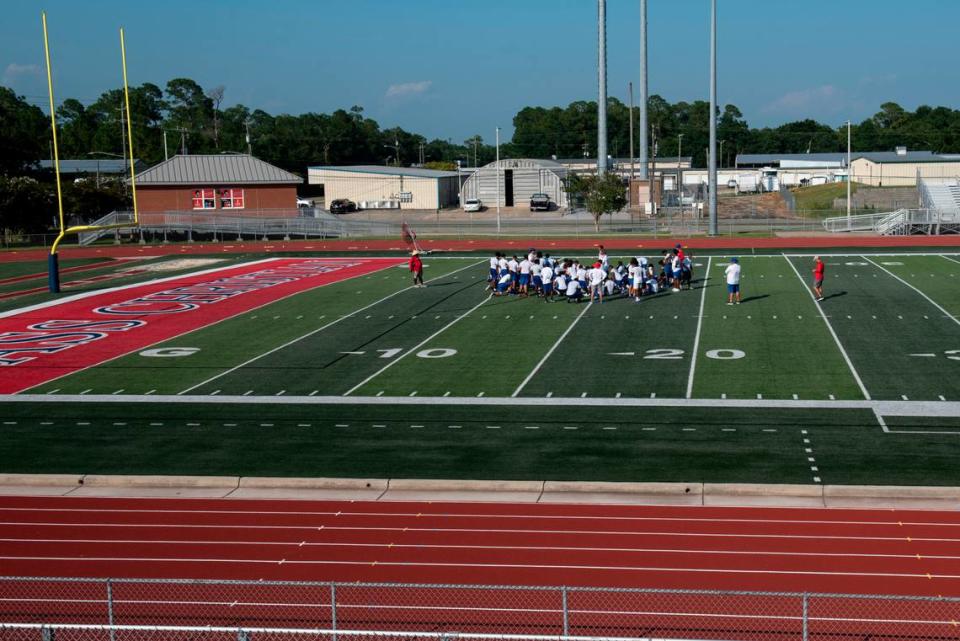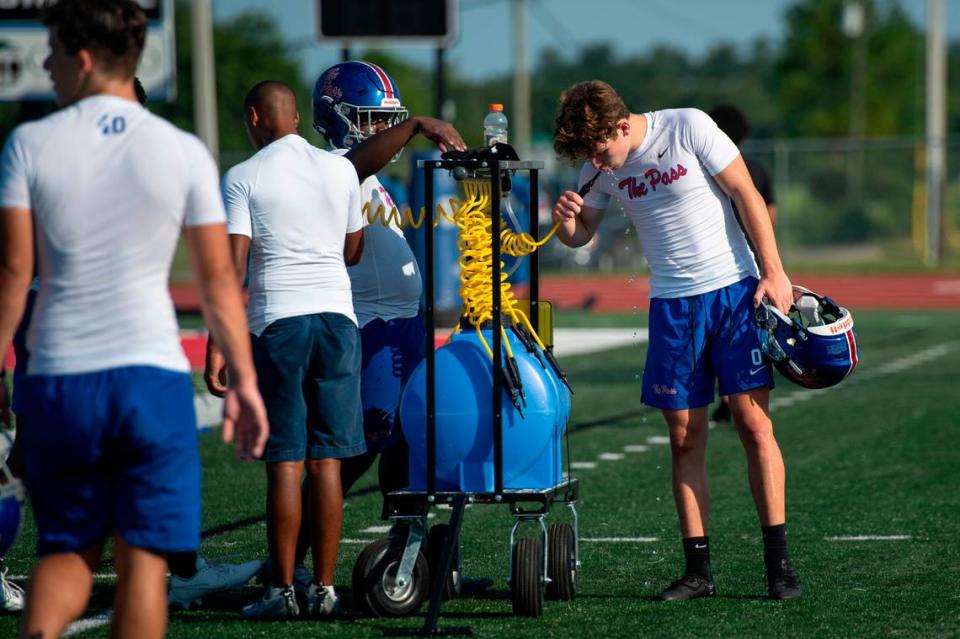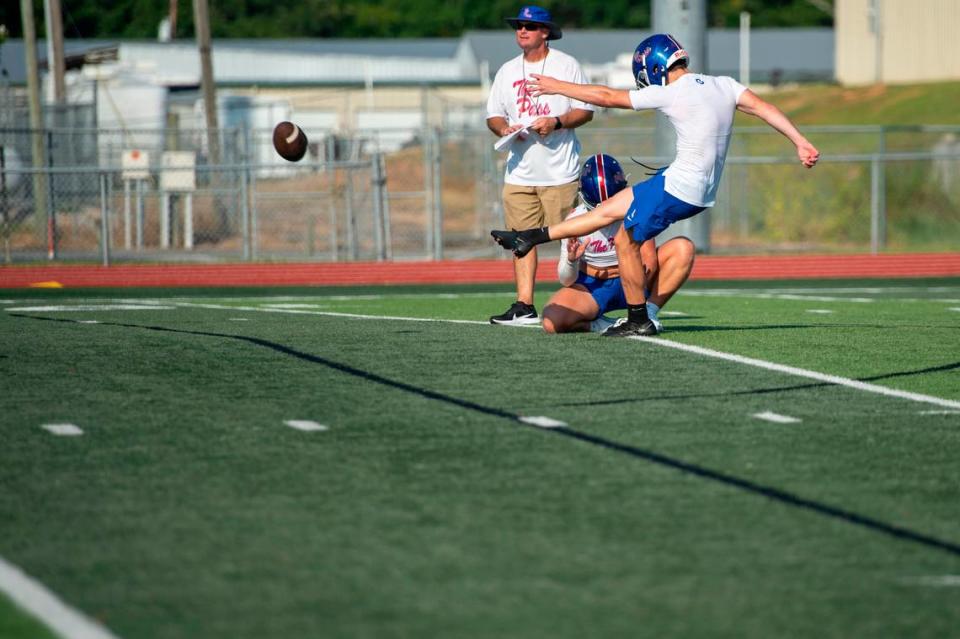Turf replaces grass at most MS Coast schools. Is it worth the cost and safety risks?
The colorful turf shining under the Friday Night Lights is becoming near-ubiquitous on the Mississippi Coast as the region barrels toward another high school football season.
Long Beach is the latest to move away from natural grass by laying turf down on its football field and resurfacing the track at Lumpkin Magee Stadium earlier this year.
The move left the Coast with just five schools still standing on real grass at their football stadiums. The trend has been growing in South Mississippi for the better part of the last two decades, even as concerns around safety begin to seep in.
Bearcat athletic director Shane Rutledge succinctly wrapped up the draw to synthetic grass in a YouTube video introducing the new field, saying “We can be on it eight hours a day and there’s no evidence of our traffic.”
For schools across the Mississippi Coast, state and rest of the country, the high durability of turf is convincing more and more districts to approve hefty expenditures on it. The grass replacement needs less upkeep and typically lasts for at least 10 years.
The cost of laying down turf, however, is not a light one, running into seven figures.
At Poplarville, the Hornets wrapped up its first athletic year with fresh artificial turf on its football, baseball and softball fields and the three projects together totaled $2.4 million.
The new turf was accompanied by a new video board and other improvements to the football facility.
Why make the investment to turf?
Poplarville football coach and athletic director Jay Beech told the Sun Herald he’s “thrilled to have our new turf” after his first season on the near-weather proof surface.
“There were times where it would rain all night, rain half the day the next day and it would be bone dry for practice,” Beech said. “In a perfect world, if you could play on a grass field, I’d say that would be the way to go.
“But at Poplarville High, that green grass is going to be dirt and dead grass after you play a Monday night JV game, turn around and play two Thursday night junior high games, the band practices on it one time. Turn around on Friday night and you don’t have grass anymore.”
Football fields are heavily trafficked at high schools throughout the school year. Outside of the busy fall season, the field is repeatedly trekked by soccer players and is subject to weather events in winter and the spring.
The nearly total lack of maintenance costs is a significant driver for schools looking to turf their fields.
“Grass, you got to fertilize it, spray with insecticide, all that,” Beech said. “You got to paint it every week, mow it three times a week, top dress it. There’s a ton of work that we would have to be doing this summer, just getting it ready. You have to go up there on a Saturday in the summer to paint lines just for practice. The maintenance, labor hours the coaching staff saves by having turf is incredible.”
Pass Christian goes to turf
Pass Christian joined the mix five years ago, laying its turf down in a 2018 project with a price tag of $1 million.
The school chose to invest in artificial grass for similar reasons as most others: a stable playing surface and reduced upkeep.
“It’s huge, just from the upkeep from it,” Pirates baseball coach and athletic director Ricky Smith said. “On the Coast, the way our soil samples are, it’s really hard to grow good Bermuda grass and keep it weed free. Growing the grass isn’t that bad, but keeping the weeds out of it is something that’s really hard to do.”
Smith says the school pays for the turf on the baseball field to be sprayed every 4-6 weeks but doesn’t have to do the same for the football field.
The Pirates, like Poplarville and dozens of others, favor the little-to-no upkeep costs over the labor and pocket-draining expenses of grass.
‘Grass is the best’ in Gulfport
But that isn’t the case at every school. Gulfport, for instance, is one of the few schools left on the Coast still playing on natural grass at Milner Stadium.
Admiral athletic director Matt Walters says the school currently has no plans to change that in the future.
“We just feel like grass is the best thing to play on,” Walters said. “Now, obviously, a turf field is going to give you an opportunity when it rains real bad to go out there and play and not have to worry about the playing surface. But we feel like if you have a well-maintained grass field and it’s in good shape, you can get those playing good.”
Walters points to last year’s Port City Bowl, where a downpour inundated the season-opening doubleheader but didn’t result in either game being postponed. “The field is crowned so well that it just drains right off.”

Significant concerns surrounding artificial turf
Walters isn’t the only person on the Coast who would prefer to keep athletes on the real thing. The athletes themselves still have their own preferences.
George County’s former dual-threat quarterback and highly-sought after recruit Deuce Knight played on a natural grass field in Lucedale that Walters calls the “Golden Standard” of grass fields. If it were up to Knight, he’d take that field to every game.
“I think I see more people get hurt on turf, like knee injuries,” Knight said. “I see you slip less on grass than you do on turf.”
And while not specific to the knee, data shows that Knight is right: there’s a growing concern around injuries on turf across the U.S.
Sports Info Solutions, a sports data collection company that works with the NFL, MLB and NBA, found that between 2017 and 2020, more injuries occurred on turf than on grass on a per-game basis in the NFL.
The areas of concern were lower extremity, such as foot or ankle injuries, and head injuries. In those four years, the NFL saw 18% more head injuries on turf than on grass and a 10 percent increase in head/foot injuries.
Even more implicatory, the NFLPA put forth its own study recently this year with similar findings. Former Cleveland Browns lineman and current union president J.C. Tretter noted players suffered injuries more often on turf than it did on grass in 10 of the last 11 seasons.
According to Smith, such injuries are still less frequent at the high school level due to the difference in athleticism. Football is a sport that is all about angles taken on the field and high school players hit those angles at significantly less force and with much less weight than NFL players.
Still, the concern remains as a legitimate one for high school athletes.
“If you ask me, I believe a grass field helps give a little bit better and helps prevent some of those high-impact injuries that you’re going to deal with in some situations,” Walters said. “I don’t have facts to back that up, that’s just from my experience from my 23 years of being involved in high school athletics.”
Turf is hotter than grass in South MS summers
Another cause for concern, especially in South Mississippi, is heat. When practices and games get underway in late August, the field-level temps can soar well above the heat index on your phone.
According to Penn State’s Center for Sports Surface Research, artificial turf can be 35 to 55 degrees warmer than the surface of natural grass.
In a state where the feels-like temperature can easily crack 100 degrees, coaches are forced to keep a close eye on their players.
The heat is Smith’s primary concern with turf and is something he and his coaches closely monitor.
Smith says their football team follows MHSAA protocol with mandatory water breaks and ice baths. The team also adheres to the acclimation periods when practice begins, beginning with shorts and helmets and slowly working up to full pads.
New MHSAA practice policies have also led to teams cutting some practices short. Some teams have had practices limited to an hour or even just 30 minutes.
“It’s just a lot of heat for the kids,” Smith said. “You have to be real proactive on your watering plan. How you organize practice with breaks, rotating kids through and then post-practice just cooling your body.”
During an evening football practice on the turf at The Pass, we used an outdoor thermometer to measure the difference. At 5:30 p.m. with the temperature sitting at 92 degrees, we measured turf temps as high as 120 degrees.
On the natural grass just a few feet away, the temps quickly dropped to 100 degrees.
The recency of research and data pertaining to injury risks and heat concerns comes at a time where affordability and long-term value have peaked for school districts who wish to turn to turf.
John Feaster, the new head coach at natural grass-school Moss Point, put the impact of artificial grass succinctly: “You never miss a day of work on turf.”



